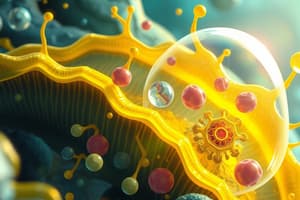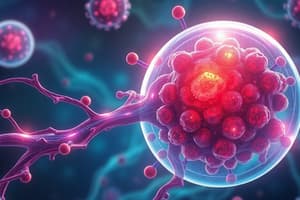Podcast
Questions and Answers
Which of the following actions is permitted under the copyright policy for year-1 course materials at St. George's University School of Medicine?
Which of the following actions is permitted under the copyright policy for year-1 course materials at St. George's University School of Medicine?
- Downloading and sharing 'view only' lecture recordings with colleagues.
- Distributing modified versions of downloaded files to students not enrolled in the course.
- Publishing parts of the course material on a personal website without permission.
- Creating print copies of downloadable files for personal use while maintaining the copyright statement. (correct)
Which cellular component is responsible for synthesizing proteins?
Which cellular component is responsible for synthesizing proteins?
- Lysosome
- Golgi Complex
- Ribosome (correct)
- Endoplasmic Reticulum
Which organelle is primarily involved in the modification, sorting, and packaging of proteins and lipids?
Which organelle is primarily involved in the modification, sorting, and packaging of proteins and lipids?
- Golgi Complex (correct)
- Peroxisome
- Mitochondria
- Endoplasmic Reticulum
What is the main function of the lysosomes?
What is the main function of the lysosomes?
Which of the following best describes the role of the cytoskeleton?
Which of the following best describes the role of the cytoskeleton?
What is the primary role of the plasma membrane?
What is the primary role of the plasma membrane?
Which transport mechanism moves molecules against their concentration gradient, requiring energy?
Which transport mechanism moves molecules against their concentration gradient, requiring energy?
How does increased membrane fluidity affect the permeability of a cell membrane?
How does increased membrane fluidity affect the permeability of a cell membrane?
A cell is placed in a solution, and it begins to swell. Which of the following cellular components is primarily responsible for preventing the cell from bursting due to the influx of water?
A cell is placed in a solution, and it begins to swell. Which of the following cellular components is primarily responsible for preventing the cell from bursting due to the influx of water?
A researcher is studying a cell and observes that it is actively secreting a large protein. Which of the following transport mechanisms is most likely involved in this process?
A researcher is studying a cell and observes that it is actively secreting a large protein. Which of the following transport mechanisms is most likely involved in this process?
In a patient with hyperglycemia (high blood glucose), such as the 65-year-old female described, which cellular process is most directly affected, leading to a disruption in cellular homeostasis?
In a patient with hyperglycemia (high blood glucose), such as the 65-year-old female described, which cellular process is most directly affected, leading to a disruption in cellular homeostasis?
If a toxin disrupts the function of the cytoskeleton, which of the following cellular processes would be most immediately affected?
If a toxin disrupts the function of the cytoskeleton, which of the following cellular processes would be most immediately affected?
Which of the following best describes the role of the plasma membrane in maintaining cellular homeostasis?
Which of the following best describes the role of the plasma membrane in maintaining cellular homeostasis?
In the provided scenario of a patient with Type 2 Diabetes, which organelle is most directly involved in the initial response to elevated blood glucose levels through insulin production?
In the provided scenario of a patient with Type 2 Diabetes, which organelle is most directly involved in the initial response to elevated blood glucose levels through insulin production?
Which of the following represents the correct sequence of cellular structures involved in the production and secretion of insulin, starting from the synthesis of the insulin protein?
Which of the following represents the correct sequence of cellular structures involved in the production and secretion of insulin, starting from the synthesis of the insulin protein?
A pharmaceutical company is designing a drug that needs to enter cells rapidly. Which strategy would best facilitate the drug's entry across the plasma membrane?
A pharmaceutical company is designing a drug that needs to enter cells rapidly. Which strategy would best facilitate the drug's entry across the plasma membrane?
Which of the following characteristics distinguishes microtubules from microfilaments?
Which of the following characteristics distinguishes microtubules from microfilaments?
Keratin, neurofilaments, and glial fibrillary acidic protein are the main components of which type of filament?
Keratin, neurofilaments, and glial fibrillary acidic protein are the main components of which type of filament?
If a cell were unable to produce tubulin, which of the following functions would be most directly affected?
If a cell were unable to produce tubulin, which of the following functions would be most directly affected?
Which of these cellular activities does NOT involve microfilaments?
Which of these cellular activities does NOT involve microfilaments?
Which of the following is a primary function of the cell nucleus?
Which of the following is a primary function of the cell nucleus?
What is the role of nuclear pores found in the nuclear envelope?
What is the role of nuclear pores found in the nuclear envelope?
Ribosomal subunits are assembled from rRNA and proteins within which cellular structure?
Ribosomal subunits are assembled from rRNA and proteins within which cellular structure?
Which of the following accurately describes the role of genes within a cell?
Which of the following accurately describes the role of genes within a cell?
How does the presence of multiple nucleoli in a cell such as a hepatocyte relate to the cell's function?
How does the presence of multiple nucleoli in a cell such as a hepatocyte relate to the cell's function?
Mature red blood cells lack a nucleus. How does this affect their function?
Mature red blood cells lack a nucleus. How does this affect their function?
What is the primary function of the cell membrane's lipid bilayer?
What is the primary function of the cell membrane's lipid bilayer?
Which of the following is a characteristic feature of integral proteins embedded in the cell membrane?
Which of the following is a characteristic feature of integral proteins embedded in the cell membrane?
How does the glycocalyx contribute to the function of a cell?
How does the glycocalyx contribute to the function of a cell?
Peripheral proteins are associated with the cell membrane in what way?
Peripheral proteins are associated with the cell membrane in what way?
If a drug were designed to block the function of the glycocalyx, which cellular process would be MOST directly affected?
If a drug were designed to block the function of the glycocalyx, which cellular process would be MOST directly affected?
Which of the following is NOT a function of integral proteins?
Which of the following is NOT a function of integral proteins?
What cellular function is NOT directly facilitated by proteins associated with the plasma membrane?
What cellular function is NOT directly facilitated by proteins associated with the plasma membrane?
A cell membrane is permeable to oxygen, carbon dioxide and steroids, moderately permeable to water and urea but impermeable to ions and large uncharged polar molecules. This is an example of:
A cell membrane is permeable to oxygen, carbon dioxide and steroids, moderately permeable to water and urea but impermeable to ions and large uncharged polar molecules. This is an example of:
Which of the following scenarios best illustrates the concept of an electrochemical gradient?
Which of the following scenarios best illustrates the concept of an electrochemical gradient?
Cilia and flagella share a common structural element in their core. What is this element, and what is its arrangement?
Cilia and flagella share a common structural element in their core. What is this element, and what is its arrangement?
In which of the following locations would you expect to find cells with a high density of microvilli?
In which of the following locations would you expect to find cells with a high density of microvilli?
Primary active transport directly utilizes which of the following as an energy source?
Primary active transport directly utilizes which of the following as an energy source?
Which transport process is characterized by movement down a concentration or electrical gradient?
Which transport process is characterized by movement down a concentration or electrical gradient?
A researcher observes a cell using energy to transport a substance across its membrane against its concentration gradient. What type of transport is MOST likely occurring?
A researcher observes a cell using energy to transport a substance across its membrane against its concentration gradient. What type of transport is MOST likely occurring?
Which of the following transport mechanisms relies directly on ATP hydrolysis to move substances across the cell membrane?
Which of the following transport mechanisms relies directly on ATP hydrolysis to move substances across the cell membrane?
A cell needs to import a large quantity of LDLs (low-density lipoproteins). Which transport mechanism would be MOST efficient for this purpose?
A cell needs to import a large quantity of LDLs (low-density lipoproteins). Which transport mechanism would be MOST efficient for this purpose?
How do symporters and antiporters facilitate secondary active transport?
How do symporters and antiporters facilitate secondary active transport?
Which of the following factors has the LEAST direct impact on the rate of simple diffusion across a plasma membrane?
Which of the following factors has the LEAST direct impact on the rate of simple diffusion across a plasma membrane?
A macrophage encounters a bacterium. Which process would the macrophage use to engulf and internalize the bacterium?
A macrophage encounters a bacterium. Which process would the macrophage use to engulf and internalize the bacterium?
Which of the following BEST describes the process of transcytosis?
Which of the following BEST describes the process of transcytosis?
What is a key difference between bulk-phase endocytosis (pinocytosis) and receptor-mediated endocytosis?
What is a key difference between bulk-phase endocytosis (pinocytosis) and receptor-mediated endocytosis?
Which transport process is responsible for the secretion of digestive enzymes by pancreatic cells?
Which transport process is responsible for the secretion of digestive enzymes by pancreatic cells?
A nerve cell releases neurotransmitters into the synapse. Which transport mechanism is directly involved in this process?
A nerve cell releases neurotransmitters into the synapse. Which transport mechanism is directly involved in this process?
Which of the following substances would MOST likely require facilitated diffusion to cross the cell membrane?
Which of the following substances would MOST likely require facilitated diffusion to cross the cell membrane?
Flashcards
Copyright protection
Copyright protection
All year-1 course materials are legally protected from copying and distribution.
Cytoplasm
Cytoplasm
The jelly-like substance inside the cell where organelles are located.
Cytosol
Cytosol
The liquid portion of the cytoplasm, which houses organelles and cellular components.
Organelles
Organelles
Signup and view all the flashcards
Plasma membrane
Plasma membrane
Signup and view all the flashcards
Passive transport
Passive transport
Signup and view all the flashcards
Active transport
Active transport
Signup and view all the flashcards
Electrochemical gradient
Electrochemical gradient
Signup and view all the flashcards
Microfilaments
Microfilaments
Signup and view all the flashcards
Intermediate filaments
Intermediate filaments
Signup and view all the flashcards
Microtubules
Microtubules
Signup and view all the flashcards
Function of microfilaments
Function of microfilaments
Signup and view all the flashcards
Function of intermediate filaments
Function of intermediate filaments
Signup and view all the flashcards
Function of microtubules
Function of microtubules
Signup and view all the flashcards
Nucleus
Nucleus
Signup and view all the flashcards
Nuclear envelope
Nuclear envelope
Signup and view all the flashcards
Genes
Genes
Signup and view all the flashcards
DNA
DNA
Signup and view all the flashcards
Lipid bilayer
Lipid bilayer
Signup and view all the flashcards
Integral proteins
Integral proteins
Signup and view all the flashcards
Glycocalyx
Glycocalyx
Signup and view all the flashcards
Selective permeability
Selective permeability
Signup and view all the flashcards
Peripheral proteins
Peripheral proteins
Signup and view all the flashcards
Concentration gradient
Concentration gradient
Signup and view all the flashcards
Transmembrane proteins
Transmembrane proteins
Signup and view all the flashcards
Electrical gradient
Electrical gradient
Signup and view all the flashcards
Cilia
Cilia
Signup and view all the flashcards
Flagella
Flagella
Signup and view all the flashcards
Microvilli
Microvilli
Signup and view all the flashcards
Passive vs Active Transport
Passive vs Active Transport
Signup and view all the flashcards
Secondary active transport
Secondary active transport
Signup and view all the flashcards
Facilitated diffusion
Facilitated diffusion
Signup and view all the flashcards
Osmosis
Osmosis
Signup and view all the flashcards
Vesicle
Vesicle
Signup and view all the flashcards
Endocytosis
Endocytosis
Signup and view all the flashcards
Phagocytosis
Phagocytosis
Signup and view all the flashcards
Receptor-mediated endocytosis
Receptor-mediated endocytosis
Signup and view all the flashcards
Bulk-phase endocytosis
Bulk-phase endocytosis
Signup and view all the flashcards
Exocytosis
Exocytosis
Signup and view all the flashcards
Transcytosis
Transcytosis
Signup and view all the flashcards
Plasma membrane role
Plasma membrane role
Signup and view all the flashcards
Cytoskeleton
Cytoskeleton
Signup and view all the flashcards
Cytosol functions
Cytosol functions
Signup and view all the flashcards
Nucleus role
Nucleus role
Signup and view all the flashcards
Study Notes
Copyright Information
- All year-1 course materials, whether printed or online, are protected by copyright.
- Copying, distributing, or publishing any part of the materials is prohibited.
- Students and faculty are permitted to make copies for personal and classroom use only, as long as the copyright statement is maintained.
- "View only" files (e.g., lecture recordings) cannot be copied.
Objectives
- Identify and describe the three main parts of a cell.
- Describe the basic structure and function of the cytoplasm:
- Cytosol: Describe structure and function of cytoskeleton.
- Organelles: Describe ribosomes, endoplasmic reticulum, Golgi complex, lysosomes, peroxisomes, proteasomes, and mitochondria.
- Nucleus: Describe structure and function of the nucleus, including the nuclear envelope, pores, nucleoli, genes, and chromosomes.
- Describe the composition and function of the plasma cell membrane.
- List the different components of the plasma membrane (phospholipids, glycoproteins, glycolipids, cholesterol) and describe their functions
- Explain membrane fluidity, permeability, and how it affects transport
- Describe the various types of transport across the cell membrane:
- Passive processes: simple diffusion, facilitated diffusion, osmosis, and osmotic pressure.
- Active Transport: Differentiate from passive processes and compare types
- Vesicular transport: endocytosis (3 types), exocytosis, transcytosis
- Explain the concept of concentration and electrical gradients and their contribution to the electrochemical gradient.
- Describe cell specializations (cilia, flagella, microvilli).
- Include typical locations and functions
Case Study (Patient)
-
A 65-year-old female with a history of Type 2 diabetes mellitus is brought to the emergency department with altered mental status (confused, disoriented), drowsiness, and dry oral mucosa.
-
Blood glucose levels are >600 mg/dL (normal is 70-100 mg/dL).
-
Treatment includes IV fluids, insulin, and electrolyte replacement.
-
Questions about the case:
- Symptom indicating cell state: What symptom indicated the state of the cells in the patient?
- Major cause of condition: What is the primary cause of the patient's condition?
- Cellular barrier: Which cell part acts as a barrier between the cell's contents and its surroundings?
- Membrane permeability's role: Explain the role of membrane permeability in response to the IV fluids given to the patient.
- Insulin production's structure: Which organelle is responsible for the instructions for insulin production?
- Insulin production process: List the cell structures involved in insulin production from synthesis to secretion.
The Cell's Parts and Function
-
Plasma membrane
-
The outer boundary of the cell
-
Selective barrier; controls the passage of substances into and out of the cell
-
Maintains cellular integrity by isolating the intracellular environment
-
Critical in communication between cells and the extracellular environment
-
Cytoplasm
-
The region within the plasma membrane, excluding the nucleus
-
Contains cytosol, which is an intracellular fluid, and organelles.
-
Nucleus
-
Membrane-bound organelle containing most of the cell's genetic material (DNA).
-
Controls cellular activities and structure by regulating gene expression and protein synthesis
Cell Structures and Function
- Organelles (small, specialized components with their own specific structural characteristics and functions):
- Centrosomes
- Cilia and Flagella
- Ribosomes
- ER(Endoplasmic Reticulum) Types- Rough ER, Smooth ER
- Golgi Complexes
- Lysosomes
- Perozisomes
- Proteasomes
- Mitochondria
- Cytoskeleton: Network of protein filaments (microtubules, intermediate filaments, microfilaments) that provides structural support and facilitates movement of organelles, chromosomes, and cells.
Membrane Transport
-
Permeable
-
Allows a substance to pass through
-
Impermeable
-
Does not allow a substance to pass through
-
Selective Permeability
-
Allows certain substances to pass more readily than others
-
Various types
-
Simple diffusion
-
Facilitated diffusion
-
Osmosis and osmotic pressure
-
Active transport (primary and secondary)
-
Vesicular transport (endocytosis, exocytosis, transcytosis)
-
Passive and Active Transport
- Passive transport: Movement of substances across the membrane without energy expenditure (e.g., simple diffusion, facilitated diffusion, osmosis).
- Active transport: requires energy (ATP) to move substances against their concentration gradients.
-
GRADIENTS
- Concentration gradients:differences in the concentrations of a molecule across a space.
- Electrical gradient:differences in electrical charge across a space(membrane potential)
- Electrochemical gradient:Combined influence of concentration and electrical gradients on the movement of a given molecule or ion.
Cell Membrane Specializations
- Cilia and flagella: Motile projections that aid in movement or fluid transport
- Microvilli: Small projections that increase the surface area for absorption and secretion.
Cell Membrane Transport Mechanisms
- Endocytosis: The process of taking substances into the cell through membrane vesicles, including:
- Receptor-mediated endocytosis
- Phagocytosis
- Bulk-phase endocytosis (pinocytosis)
- Exocytosis: The process of releasing substances out of the cell through membrane vesicles.
- Transcytosis: The process of moving substances across cells (e.g., epithelial cells).
Studying That Suits You
Use AI to generate personalized quizzes and flashcards to suit your learning preferences.



